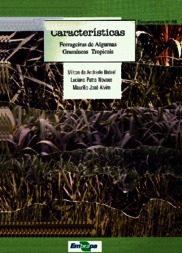Strategies for managing tropical grasses on forage production and quality and animal performance
Strategies for managing tropical grasses on forage production and quality and animal performance

Photo: Gomide, Carlos Augusto de Miranda
Low productivity of pastures in Brazil is the main cause of poor profitability and competitiveness of animal production systems in relation to other agricultural systems. The objective of the project was to generate technologies in intensive system of livestock grazing using Tanzania grass ( Panicum maximum), Marandu palisadegrass ( Brachiaria brizantha) and Star grass ( Cynodon nlemfuensis) to improve forage production and quality and milk production. To this end, evaluations were made with the defoliation interval (rest period) fixed or defined according to light interception (Tanzania grass and Marandu palisadegrass), different rates of nitrogen under irrigation (grass Star-African), and monitoring the performance of crossbred Holstein cows x Zebu in irrigated pasture fertilized with increasing doses of nitrogen and managed in a rotational system (Star grass). Among the various results, it is worth mentioning the high economic efficiency achieved with Star grass. The nitrogen rate to achieve maximum biological production ranged from 430 to 532 kg / ha. In the case of the maximum occupancy rate, such a rate ranged from 412 to 496 kg / ha. For Marandu palisadegrass, the pre-grazing height which coincided with 95% light interception was 35 cm. The average rest period for achieving the goal of 95% light interception was 24 days. The residual height ranged between 20 and 25 cm with an averaged value of 23 cm. The management with variable rest period allowed greater stocking rate (6.6 AU / ha) and milk production per area (93.5 kg / ha / day), compared to management with fixed period of 30 days (5, 0 AU / h and 71.3 kg / ha / day). For Tanzania grass, the pre-grazing height to reach 95% light interception ranged between 90 and 100 cm. The average residue height was 50 cm. The average milk production was 12.6 kg / cow / day and the stocking rate was 6.8 AU / ha, with animals receiving 2 kg of concentrate feed per day. The management with variable rest period allowed for high milk production per area (99.7 kg / ha / day).
Ecosystem: Coastal Areas, Atlantic Forest, Mid-North, Cerrados Region, Pinheirais Region
Status: Completed Start date: Sat Oct 01 00:00:00 GMT-03:00 2011 Conclusion date: Wed Dec 31 00:00:00 GMT-03:00 2014
Head Unit: Embrapa Dairy Cattle
Project leader: Carlos Eugenio Martins
Contact: carlos.eugenio@embrapa.br



